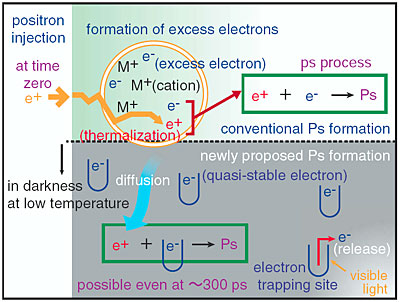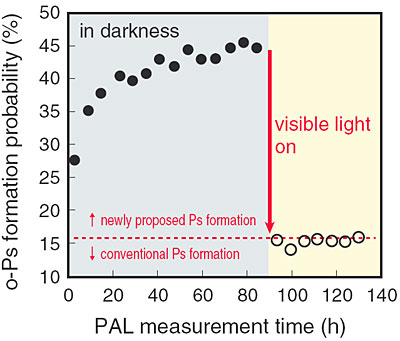
The positron is an antiparticle of the electron discovered by Anderson in 1832. It annihilates with the electron and the mass energy is emitted as gamma rays. Most of the annihilation occurs in the two-photon emission process in condenced phase. Measuring this annihilation gamma rays is the positron annihilation method. By measuring gamma rays, various information can be obtained.Simply, it is energy and time information.The energy is affected by the momentum of positrons and electrons at the time of annihilation, and the Doppler effect occurs.In material research, this makes it possible to measure the momentum of electrons at the time of annihilation, and is mainly sensitive to defects that change the rate of annihilation with inner-shell electrons.
On the other hand, in insulating materials, positronium, which is a bond state of an electron and a positron, is formed.This formation process has been carried out for many years since the positron discovery, and a formation model that can explain the phenomenon in gas is proposed by Ore in 1949, and the spar reaction model that can explain the phenomenon in solid or liquid in 1974 was proposed by Mogensen. However, since around 1980 to 2000, the significant increase in positronium formation that occurs at low temperatures is not explained by these models, and a number of misinterpreted papers are published. We explain the phenomena that occur at low temperatures, as shown in figure 1, by weakly bound electrons , and then succeed in showing validity in many verification experiments, and their interpretations are all over the world [1]. Figure 2 is an example of that, showing the effect of visible light.

Fig.1 Formation mechanism of positronium in substance. Conventional positronium formation is a reaction between excess electrons and thermalized positrons, which is believed to be occurring up to a few picoseconds. New positronium formation process occurs when metastable electrons are accumulated at low temperatures in dark, by such as the ionization of previously injected positrons, and positrons that escape the conventional positronium formation diffuse to find metastabilized electrons. Therefore, as shown in the figure, it gradually increases. Also, because it occurs after diffusion, formation can be seen even after hundreds of picoseconds.

Fig.2 Positron annihilation lifetime measurement time dependence of the formation yield of ortho-positronium formation (75% of total positronium formation) in cyclohexane at 77 K (●; in darkness, ○; under visible light). At low temperatures in darkness, metastabilized electrons are formed and accumulated by ionization by incident positrons, and as a result, new positronium formation as shown in the figure 1 increases. As shown in the figure 1, the metastable electrons are extinguished by visible light, so only the component (about 16%) due to the conventional positronium formation remains.
Positronium is trapped in the subnanoscale voids. Triplet positronium (ortho-positronium), shows annihilation lifetime dependence on the size of vacant space. Although the free volume in polymer science is defined as a macroscopic quantity, the lifetime evaluation of ortho-positronium enables evaluation ofthe size of the microscopic free volume and discussion of free volume distribution etc. Therefore it is used in many fields. Recently, we have succeeded in discovering oscillations in the GHz range of ortho-positronium annihilation rates in room temperature ionic liquids [2]. Subsequent studies have revealed that this oscillation is caused by the structure formed by the Coulomb force between ions in a room temperature ionic liquid[3]. It is expected as a new analysis method in the future.
In addition, positronium formation is usually formed in about 1 picosecond, so the formation process can be used to study very fast reactions. On the other hand, positronium in singlet state, para-positroniuim, has a intrinsic annihilation lifetime as fast as 125 picoseconds in vacuum but ortho-positronium that is in triplet state shows long lifetime of 142 nanoseconds, more than 1000 times longer than para-positronium. As a result, by using ortho-positronium as a probe, it is possible to study reactions in the nanosecond range.For example, in water, there is a spin correlation between unpaired electrons in the OH radical formed by ionization occurring at the end of the incident positron track and the positronium formed with the excess electrons emitted by the ionization and the incident positron itself. Therefore, quantum beats are observed in reactions between them [4]. In experiments using this spin correlation, it is becoming possible to study the behavior of OH radicals in water.
For example, when a positron is incident in a metal crystal, the positrons relatively annihilate with the inner shell electrons if no defect exists.If atomic vacancies or vacancy clusters exist, positrons will be trapped there, thus reducing the probability of annihilation with inner-shell electrons.On the other hand, if the positron incidence time is known, the difference between the time information and the annihilation gamma ray detection time is the positron lifetime.If Na-22 is used, 1.27 MeV gamma rays are emitted at the time of positron emission, so measurement of the positron annihilation lifetime is possible, and a time resolution of 200 picoseconds (FWHM) or less can be obtained relatively easily at present. In this method, the overlap between positrons and electrons becomes large in the defect free state and the lifetime becomes short, while the lifetime becomes long if atomic vacancies or vacancy clusters exist and positrons are trapped there.Thus, it is an extremely sensitive method to pores in the crystal, and is one of the important methods in the material engineering field. The fields in which this method can be used are very broad. We are also conducting researchs on the embrittlement [5] and the crack propagation [6] etc..
The positron annihilation method is a cutting edge method on gamma ray measurements, and the method is also being developed.For example, by dramatically advancing the time resolution of positron annihilation lifetime measurement, new phenomena are captured and new research becomes possible. The same is true for count rates.Recently, by performing waveform analysis, we developed a method to perform detector discrimination and applied it to the positron annihilation method[7]. Until now, the signal from the detector was sent as it is to the analysis system, where data was stored and analyzed. We have developed a technology that transports the signal from the detectors with a single cable and performs waveform analysis to discriminate the detectors and to accumulate and analyze data.Even if the number of detectors is increased, it is not necessary to increase the analysis system proportionately, and it is possible to operate particularly large-scale devices economically.
[1] Tetsuya Hirade, Frans H.J. Maurer, Morten Eldrup, Radiation Physics and Chemistry, 58, (2000) 465-471. (Japan Radiation Chemistry Association Academic Award)
[2] Tetsuya Hirade, Positronium bubble oscillation in room temperature ionic liquids, Japanese Journal of Applied Physics Conference Proceedings, 2 (2014) 011003.
[3] Tetsuya Hirade, "Positronium in room temperature ionic liquids", AIP Conference Proceedings 2182, (2019) 030007.
[4] T.Hirade, Chem. Phys. Lett. 480, (2009) 132-135.
[5] T. Doshida, H. Suzuki, K. Takai, N. Oshima, T. Hirade, Enhanced Lattice Defect Formation Associated with Hydrogen and Hydrogen Embrittlemant under Elastic Stress of a Tempered Martensitic Steel, ISIJ International, vol52, (2012) 198-207. (Japan Iron and Steel Institute Sawamura Dissertation Award Winning Paper, Ministry of Education, Culture, Sports, Science and Technology nanotechnology platform 2013 6 major achievement awards)
[6] R. S. Yu, M. Maekawa, Y. Miwa, T. Hirade, A. Nishimura and A. Kawasuso, Positron microscopic analysis of crack failure in stainless steels, physica status solidi (c) 4, (2007) 3577-3580.
[7] T. Hirade, H. Ando, K. Manabe, D. Ueda, Nuclear Inst. and Methods in Physics Research, A 931 (2019) 100-104.